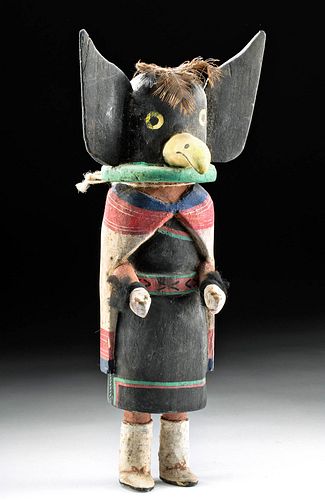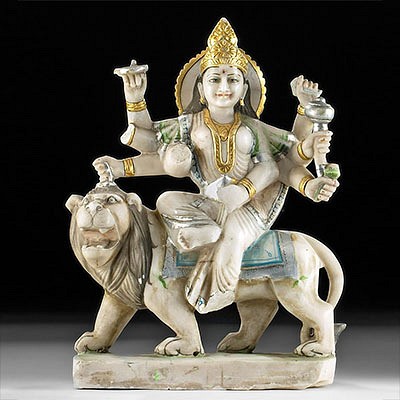Native American Painted Wood Kachina, 1940s
Lot 142c
About Seller
Artemis Fine Arts
686 S Taylor Ave, Ste 106
Louisville, CO 80027
United States
Selling antiquities, ancient and ethnographic art online since 1993, Artemis Gallery specializes in Classical Antiquities (Egyptian, Greek, Roman, Near Eastern), Asian, Pre-Columbian, African / Tribal / Oceanographic art. Our extensive inventory includes pottery, stone, metal, wood, glass and textil...Read more
Estimate:
$1,800 - $2,500
Absentee vs Live bid
Two ways to bid:
- Leave a max absentee bid and the platform will bid on your behalf up to your maximum bid during the live auction.
- Bid live during the auction and your bids will be submitted real-time to the auctioneer.
Bid Increments
| Price | Bid Increment |
|---|---|
| $0 | $25 |
| $300 | $50 |
| $1,000 | $100 |
| $2,000 | $250 |
| $5,000 | $500 |
| $10,000 | $1,000 |
| $20,000 | $2,500 |
| $50,000 | $5,000 |
| $100,000 | $10,000 |
| $200,000 | $20,000 |
About Auction
By Artemis Fine Arts
Jul 16, 2020
Set Reminder
2020-07-16 10:00:00
2020-07-16 10:00:00
America/New_York
Bidsquare
Bidsquare : Ancient / Ethnographic Art Through The Ages
https://www.bidsquare.com/auctions/artemis-gallery/ancient-ethnographic-art-through-the-ages-5334
Ancient art from Egypt, Greece, Italy and the Near East, as well as Asian, Fossils, Pre-Columbian, Native American, African / Tribal / Oceanic, Spanish Colonial, Russian Icons, Fine art, much more! Artemis Fine Arts info@artemisfinearts.com
Ancient art from Egypt, Greece, Italy and the Near East, as well as Asian, Fossils, Pre-Columbian, Native American, African / Tribal / Oceanic, Spanish Colonial, Russian Icons, Fine art, much more! Artemis Fine Arts info@artemisfinearts.com
- Lot Description
Native American Indian, Southwest, Hopi or Navajo, ca. 1940s CE. A hand-carved and hand-painted wooden katsina/kachina in the form of a bird of prey, perhaps an owl known as Mongwa and symbolic of wisdom and intelligence, or perhaps a raven, with a black mask and yellow beak, dressed in a colorful cloak and garment beneath, black cuffs, and white boots - and with bird feathers atop the head. Kachina figures are meant as gifts for children representing kachina dancers and the supernatural katsinam beings they embody. The Hopi believe that the Mongwa kachina keeps rodents away from the fields and thus brings about a beneficial harvest. The Mongwa Katsina is among the dancers who knock sense into the katsina clowns during the Plaza Dances or who appear in the Soyohim (mixed Katsina dances) during the late spring. Size: 12" H (30.5 cm)
Plaza Dances may be either Mixed Katsina Dances (Soyohim) in which dancers representing all the different types of katsinas attend, or a dance that includes only katsinas of the same type. Regardless, in addition to bringing about rain and fertility, all of the katsinas have a distinct purpose. Dances may be performed to commemorate a special event such as recovery from an illness, the welcomed return of a son from the army, or a birthday. Nevertheless, these dances maintain a religion quality for the Hopis.
The Katsinam, supernatural beings who live in the high mountains of the San Francisco Peaks above traditional Hopi territory, speak to the Hopi through costumed dance and song. These dancers emerge from the round ceremonial kivas that are at the center of their communities, singly or in groups, and dance to the music of drums, rattles, and song. In imitation and representation of them are Katsina figures (katsina dolls, katsin-tihu), made of cottonwood root. Cottonwood is culturally symbolic because the cottonwood tree, once abundant in traditional Hopi lands, grows where water flows - thus, looking across a landscape, lines of cottonwood trees denote a water source in the desert. After carving, the figures are painted all over with whitewash, made from kaolin clay, and then painted in brilliant colors. Originally these were done using yucca brushes. Many of them are then decorated with other materials, like feathers, cloth, or fur. Katsina dolls are often given objects to hold which indicate their roles.
Provenance: ex private Ventura County, California, USA collection, acquired prior to 2008
All items legal to buy/sell under U.S. Statute covering cultural patrimony Code 2600, CHAPTER 14, and are guaranteed to be as described or your money back.
A Certificate of Authenticity will accompany all winning bids.
We ship worldwide and handle all shipping in-house for your convenience.
#153973Tip of one ear reattached. Minor surface wear with some scuffs/losses to paint and stains on white areas of shawl. Otherwise very good.Condition
- Shipping Info
-
All shipping is handled in-house for your convenience. Your invoice from Artemis Gallery will include shipping calculation instructions. If in doubt, please inquire BEFORE bidding for estimated shipping costs for individual items.
-
- Buyer's Premium



 EUR
EUR CAD
CAD AUD
AUD GBP
GBP MXN
MXN HKD
HKD CNY
CNY MYR
MYR SEK
SEK SGD
SGD CHF
CHF THB
THB














